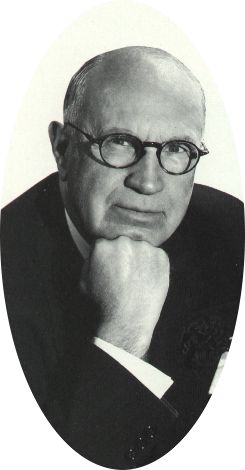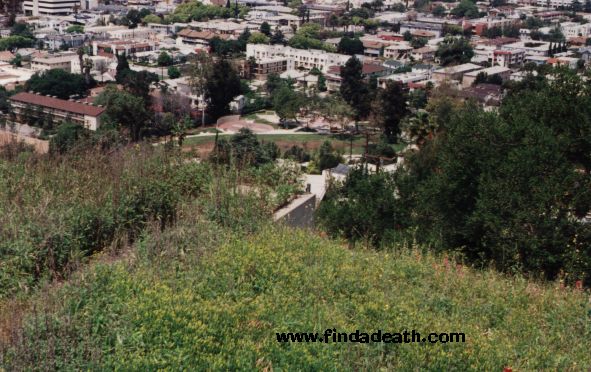June 3, 1881 – September 20, 1966

Hubert Eaton was the founder of Forest Lawn Memorial Parks in Southern California. In fact, Eaton was responsible for revolutionizing the funeral industry. He established what is now known as the “memorial park,” which just means that the gravestones are uniformly flush with the ground, to give it a more “park like” feel. He thought it made it less depressing than regular bone-yards (it also cuts down on lawn mowing expenses). The “pre-need” program was another innovation. People could make their own funeral arrangements before they became necessary – basically meaning, “buy now, pay later.”
Hubert also tried something else that hadn’t been done before. He wooed couples wishing to get married, to Forest Lawn’s horribly tacky reproduction churches to exchange vows. Unbelievably, it worked (ask Ronald Reagan and Jane Wyman), and by the time he died, over 50,000 weddings had been performed in these locales.
Somewhere along the line, someone convinced this guy that he had good taste, and Eaton took it upon himself to invest in art. Sculptures, mosaics, even the “Garden of Mexican Heritage” graces the grounds of all the Forest Lawns. Mostly it’s just crap reproductions. There’s a 25-foot statue of Michaelangelo’s David in Forest Lawn Glendale, whereas Forest Lawn Covina has the “largest religious mosaic in the Western Hemisphere, measuring 172 feet by 35 feet. Only in America. Don’t even get me started on the “Last Supper Window,” in the Great Mausoleum in Glendale. Okay, I will. It’s a huge stained glass replica of DaVinci’s Last Supper. Then they have this horrible presentation of it, complete with unveiling, every half-hour, including the supposedly eerie legend about the “Judas” glass breaking a few times before the completion (dull stupid dull). The only thing good about the window is that it gives us grave hunters a bit of time to have a gander at the famous graves.
During his tenure at Forest Lawn, Huey lived at the end of Alta Vista, in Glendale, just below the cemetery. I’ve never been to the house, but a person I once knew went in and said it had a secret passageway etc., but the really interesting part was the incline/railway that ran uphill from his house to Forest Lawn Glendale. Here’s what’s left of it,

near to that horrible Easter painting exhibit/museum thing.
After he left active duty at Forest Lawn, Huey moved from his house on Mission Road, to Beverly Hills. His house was located at 837 Greenway Drive.

Just around the corner from Bugsy Siegel‘s death spot. It was in this house that Hubert bit the big one.
According to what I could gather, Hubert had been ill for quite some time. He had a bout with prostate cancer, as well as hardening of the arteries and osteosclerosis. Eventually the end came September 20, 1966, at 5pm. He developed a blood clot in his brain. Blammo. Done.

I know nothing of his memorial service, I’m sure his fellow cronies from Forest Lawn had a real shindig in one of the storybook churches at Glendale. Update Dec 99 – thanks to Bob Siler for this information:
Hubert Eaton’s funeral was held on September 26, and attended by 1000 business and cultural leaders including George Randolph Hearst, Joe E. Brown, Greer Garson, Ronald Reagan. Honorary pallbearers were Herbert Hoover Jr. and Walt Disney. I swear to God. Richard Nixon was invited to attend, but was busy doing something important.
The service was held in the Hall of the Crucifixion and Resurrection, that gaudy ass place on the hill in Forest Lawn Glendale. Hundreds of employees lined the corridor. Here’s a direct quote from the paper:
“The ceremony began with an organ performance as Forest Lawn’s 18 regents (directors) paraded to the front of the hall in flowing red robes and red sailor type caps. A tenor sang, “Ah, Sweet Mystery of Life.”
This is the best part:
He was entombed in an elaborate ceremony in which he was formally inducted as an Immortal of Forest Lawn Memorial Court of Honor. Only five previously designated Immortals are entombed in the room. They are Dr. Robert F. Millikan, Nobel Prize winning scientist, Carrie Jacobs Bond, the composer, Jan Styka that artist who painted the garish Crucifixion painting housed in the building, Gutzon Borglum, sculptor of Mount Rushmore and Rufus B. Von Klein-Smid, former chancellor of the University of Southern California.
Probably all his poker buddies. Liquor in the front, poker in the rear.
Hubert is interred in the Great Mausoleum.

He picked the prime spot for himself and family.
Trivia: In 1938, when they were making the film, “The Wizard of Oz,” some of the little people that were playing Munchkins in the film went on a day trip to Forest Lawn, Glendale. Here they are.

The tiny one on the left is Nita Krebs, who played the littlest ballerina in the Lullaby League.
More Trivia: Hubert Eaton searched for 25 years, and finally found an image of Christ smiling, to go with all the other God awful crap they have in those cemeteries.
I think Forest Lawn now train their employees at Stepford University, and are of no help whatsoever if you are searching for a well-known person’s grave. If you ever want to make a Forest Lawn employee blow a circuit, go in to the office with a camera, and DEMAND to know where Jimmy Stewart is buried. Go on, it’ll be fun.
Update on the Hubert House
The summer of 2004 was brightened considerably when an email arrived from the gentleman that owns Dr. Hubert Eaton’s former home, just below Forest Lawn Glendale. The man, identified only as Dr. R, graciously invited the Death Hags to tour his humble abode. With baited breath, about a dozen of us arrived, and were treated to a terrific tour of Hubey’s old digs.
My particular fascination is with the Fanicular/Railway that stretched from the house – up the hill to the cemetery, where a limousine would await to take Eaton to work. Also, when Eaton would entertain, he would have his guests park at the cemetery, and take the incline down. This sign was made a gift to me by Dr. R, and I treasure it. The actual control box still exists, though the cables and tracks are pretty much gone.
Inside the main house, which I took shamefully few snaps, the most fun was the fireplace with the Forest Lawn symbol carved in to the corners. We were shown the beautiful views, Mrs. Eaton’s old dressing room, and the guesthouse. Of particular interest to me, was the mailbox.
Eaton also had bomb shelters built, one of which is now the movie theater.
In Dr. R’s own words, “Eaton did have 2 electrical systems, on that was metered by the city and one that was… well, “unmetered” by Forest Lawn. Eaton also bootlegged water from Forest Lawn, with a series of valves that turned off the city water and used the water from Forest Lawn.
There was once a servants bell system connected to each room in the house. The Eaton’s would buzz for service whenever he needed. Unfortunately, none of the system survives save that of the old wiring in the attic, and the two buzzers – one in the living room, the other in the floor of the dining room.
Eaton was not a real doctor. The “Dr.” in front of his name was given to him emeritus.”
Unfortunately, the house is now being put on the market. The price? email me if you are seriously interested. This house is awesome. A very hip crib. I will miss the good Doctor and family, as we’ve become friends. I am happy to have made their acquaintance.

Hubert Eaton was the founder of Forest Lawn Memorial Parks in Southern California. In fact, Eaton was responsible for revolutionizing the funeral industry. He established what is now known as the “memorial park,” which just means that the gravestones are uniformly flush with the ground, to give it a more “park like” feel. He thought it made it less depressing than regular bone-yards (it also cuts down on lawn mowing expenses). The “pre-need” program was another innovation. People could make their own funeral arrangements before they became necessary – basically meaning, “buy now, pay later.”
Hubert also tried something else that hadn’t been done before. He wooed couples wishing to get married, to Forest Lawn’s horribly tacky reproduction churches to exchange vows. Unbelievably, it worked (ask Ronald Reagan and Jane Wyman), and by the time he died, over 50,000 weddings had been performed in these locales.
Somewhere along the line, someone convinced this guy that he had good taste, and Eaton took it upon himself to invest in art. Sculptures, mosaics, even the “Garden of Mexican Heritage” graces the grounds of all the Forest Lawns. Mostly it’s just crap reproductions. There’s a 25-foot statue of Michaelangelo’s David in Forest Lawn Glendale, whereas Forest Lawn Covina has the “largest religious mosaic in the Western Hemisphere, measuring 172 feet by 35 feet. Only in America. Don’t even get me started on the “Last Supper Window,” in the Great Mausoleum in Glendale. Okay, I will. It’s a huge stained glass replica of DaVinci’s Last Supper. Then they have this horrible presentation of it, complete with unveiling, every half-hour, including the supposedly eerie legend about the “Judas” glass breaking a few times before the completion (dull stupid dull). The only thing good about the window is that it gives us grave hunters a bit of time to have a gander at the famous graves.
During his tenure at Forest Lawn, Huey lived at the end of Alta Vista, in Glendale, just below the cemetery. I’ve never been to the house, but a person I once knew went in and said it had a secret passageway etc., but the really interesting part was the incline/railway that ran uphill from his house to Forest Lawn Glendale. Here’s what’s left of it, near to that horrible Easter painting exhibit/museum thing.
After he left active duty at Forest Lawn, Huey moved from his house on Mission Road, to Beverly Hills. His house was located at 837 Greenway Drive. Just around the corner from Bugsy Siegel‘s death spot. It was in this house that Hubert bit the big one.
According to what I could gather, Hubert had been ill for quite some time. He had a bout with prostate cancer, as well as hardening of the arteries and osteosclerosis. Eventually the end came September 20, 1966, at 5pm. He developed a blood clot in his brain. Blammo. Done.
